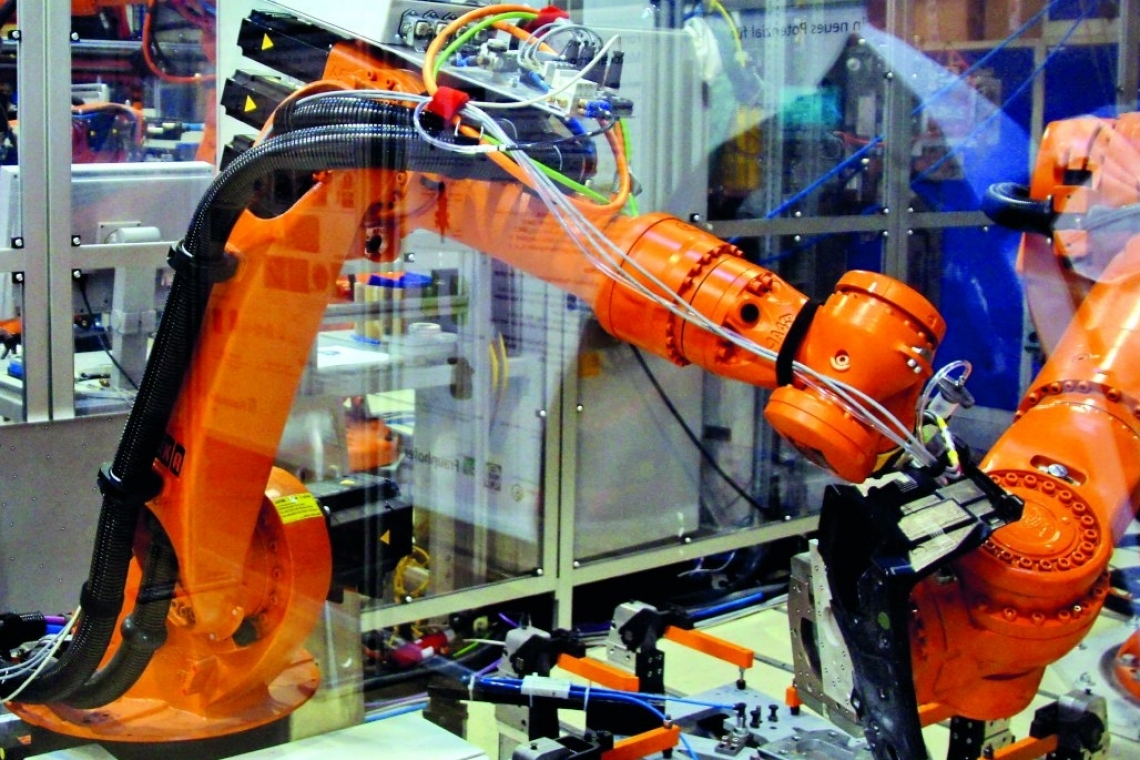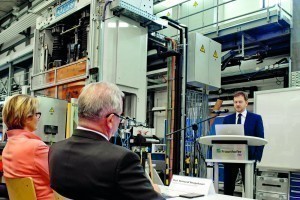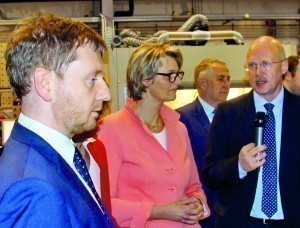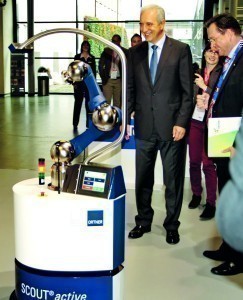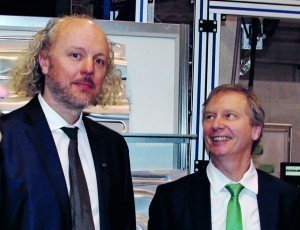Robotics companies and research institutions in 'Silicon Saxony' are producing more and more internationally acclaimed innovations in robotics technologies. University spin-offs and new robotics companies are contributing to this, as are established automation companies and unique clusters of excellence. The 'Robot Valley Dresden' alliance has now been formed to raise the region's profile as a valley of robot technologies and increase its economic strength in this field.
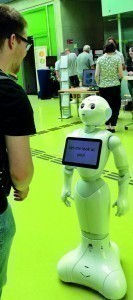 Fig. 2: Robot-human relationship - the humanoid robot 'Pepper' has been supporting the research of the Chair of Adaptive Dynamic Systems at TU Dresden since November 2018"Numerous companies that are involved in robotics in one way or another have now settled in and around Dresden," emphasized Robert Franke, Head of the Dresden Economic Development Agency. Robotics complements the focal points of the microelectronics and software industry in Silicon Saxony very well in conjunction with the region's strong mechanical engineering sector, which is also based on the strong era of precision engineering and office machine technology as well as the watch industry in Saxony's history. As a result, the Saxon state capital can and wants to set its own accents in robot technologies and make a name for itself as a robotics stronghold. The vision is to have its own robot production facility.
Fig. 2: Robot-human relationship - the humanoid robot 'Pepper' has been supporting the research of the Chair of Adaptive Dynamic Systems at TU Dresden since November 2018"Numerous companies that are involved in robotics in one way or another have now settled in and around Dresden," emphasized Robert Franke, Head of the Dresden Economic Development Agency. Robotics complements the focal points of the microelectronics and software industry in Silicon Saxony very well in conjunction with the region's strong mechanical engineering sector, which is also based on the strong era of precision engineering and office machine technology as well as the watch industry in Saxony's history. As a result, the Saxon state capital can and wants to set its own accents in robot technologies and make a name for itself as a robotics stronghold. The vision is to have its own robot production facility.
To promote this trend, robotics experts founded the 'Robot Valley Dresden' alliance in mid-2020. The aim is to inspire small and medium-sized companies to use new technologies and, in particular, to develop robot-based automation solutions that enable humans and robots to perform tasks together in the same working environment. The coordinator is Prof. Steffen Ihlenfeldt from the new Fraunhofer Center for Cyber-Physical Production Systems (CPPS) at the Fraunhofer IWU and the Institute for Mechatronic Mechanical Engineering at TU Dresden. "Our alliance will ensure that robotics will be a flagship for Dresden in the long term."
Prof. Welf-Guntram Drossel, Director of the Fraunhofer IWU, emphasized at this event that corona in particular has shown how important a new, more crisis-proof and flexible way of producing is in Germany and Europe: "We need machines, robots and factories that can quickly compensate for collapsed supply chains and sick employees. Future robots and systems must be able to quickly learn from another machine thousands of kilometers away in China or northern Italy how to produce the required component here in Germany.
In Dresden, Volkswagen, the chip manufacturers Infineon and Globalfoundries, as well as the high-tech surgeons at the university hospital, are important users of robot technology who can immediately implement the innovations of regional developers and support the developments with their application and hardware expertise. The Dresden-based automation specialists AIS Automation Dresden GmbH, Fabmatics GmbH, SYSTEMA Systementwicklung GmbH and XENON Automatisierungstechnik GmbH are also key players in the growing Robot Valley Dresden. They are the top experts for the robot-supported post-automation of large factories. As founders of the 'Automation Network Dresden' (ANT), they bring experts from leading global companies from the USA to Japan to Dresden every year for the international 'Innovation Forum for Automation' to discuss industry trends, requirements, developments and experiences in the automation of high-tech manufacturing. In the wake of Corona, the 18th Innovation Forum for Automation was transformed into a series of digital events in the first four months of this year.
Infineon's robotics strategy, which was initiated after the 2008/2009 crisis, was and remains controversial, but has long been regarded as a blueprint for Europe's semiconductor industry. Much of the technology for the subsequent automation of the older chip factory modules for 200 mm wafers at Infineon Technologies Dresden GmbH was designed and built by specialist companies from the region such as Fabmatics (a merger of Hap and Ortner). On the one hand, far fewer people are now working in these fabs with comparable production volumes than before, and on the other hand, far higher quality requirements, e.g. for the automotive industry, can be met. This and the conversion to copper technology created orders and the 200 mm production is now more competitive within the Group and internationally, the danger of the economic orcus of the memory chip subsidiary Infineon was prevented. The collaborative robots used by Metralabs GmbH Ilmenau are omnipresent in the Dresden chip plants: "Some have cuddly baby seal eyes, others just arms. Some stand there stoically and perform the same steel hand movements for hours on end. Still others roll through the cleanroom aisles and politely avoid human colleagues they encounter," reports the news portal Oiger. "It was a good thing that we left their heads on," says Infineon automation expert Harald Heinrich. "As a result, the employees accepted the robots much better."
And the engineers and researchers in the Cluster of Excellence Centre for Tactile Internet with Human-in-the-Loop at TU Dresden CeTI, which works closely with the Fraunhofer CPPS in the alliance, are already thinking a few years ahead. They want to make skills such as precision assembly, playing the piano or baking cakes freely transferable between humans and machines so that once a master, human or robot, has acquired a skill, it is never lost again. This democratizes skills, making them accessible to everyone, similar to the democratization of knowledge through the Internet, explained CeTI spokesperson Prof. Frank Fitzek.
The 'Robo-Operator' developed by Industrie-Partner GmbH from Coswig near Dresden in collaboration with the Fraunhofer IWU (Dresden branch of the institute) is intended to absorb order peaks and increased sickness rates. This artificial temporary worker can be rolled up to machine tools so that, after a short training period, it can take over the night shift for the missing human colleague. "However, our approach is not to make skilled workers unemployed," emphasizes Managing Partner Ralf Hock. "The problem for most companies is that they can no longer find good CNC millers or lathe operators on the job market. Thanks to our Robo, SMEs will also be able to accept orders in future that were previously only worthwhile for highly automated companies.
Franconian packaging machine manufacturer Gerhard Schubert is setting up the 'Schubert Motion' development center in the Saxon state capital. The aim is to use intelligent control systems to teach Schubert robots not to get in each other's way, even when working at high speeds in factories. This should prevent accidents, increase productivity and enable preventative repairs.
The state capital's economic development agency wants to promote robotics as a module in Dresden's 'Smart Systems Hub' technology network and, above all, increasingly provide offices, pilot plants and building space in the municipal technology parks and centers for institute spin-offs and robotics companies looking to set up in Dresden.
The 'Universelle Werke' technology center in Dresden was expanded from 2017 with a focus on lightweight construction and robotics companies(PLUS issue 7/2019 p. 1092). In addition to a South Korean lightweight construction center and parts of the ILK at TU Dresden, Krauss-Maffei Technologies (Kuka robots), remnants of Plastic Logic GmbH, the Fraunhofer CPPS and a DLR institute have also settled here. Now the robot software company Coboworx GmbH from Rhineland-Palatinate has also relocated its headquarters here. "The speed and interdisciplinarity in Dresden convinced us. That's why we moved to the heart of the 'Silicon Saxony' technology region. "The technological environment and the scientific infrastructure here suit us," explained co-founder Olaf Gehrels. In a joint project with the Fraunhofer IWU, they want to identify and eliminate potential safety risks for humans before collaborative robots (cobots) are used in factories. Cobots are robots that work hand in hand with human colleagues instead of in a shielded cage, as traditional industrial robots do. The solution favored in the project is a digital twin, a kind of computer simulation of the entire production plant. This allows the safety tests to be carried out while the robots are still being assembled.
The TU Dresden spin-off Wandelbots is also developing sensor jackets and pens with which any skilled worker can train a robot for a new job in their company without any programming knowledge and thus turn it into a cobot. In addition, the use of robots should become so cheap and simple that every small backyard workshop will be able to afford a robot in the future. The author reported on this in PLUS issue 11/2020 page 1529.
Prof. Ulrike Thomas from Chemnitz University of Technology would like to establish manufacturers of sentient and walking robots in Saxony that are suitable for use as cobots. Prof. Thomas and doctoral student Hongxi Zhu have patented a flexible robot joint. This is designed to prevent the artificial assistants made of steel, plastic and silicon from injuring the people they interact with. The Barkhausen Institute at TU Dresden wants to make such robots, which work directly with and alongside humans, more reliable. 'Trustworthiness for the tactile Internet of Things' is the official name of this research facility. The founder of the Barkhausen Institute, Prof. Gerhard Fettweis, put it more simply: "We want to prevent robots from suddenly starting to slap people in the face."
A parallel or delta robot for particularly high-speed industrial applications was developed at the Chair of Processing Machines and Technology at TU Dresden. The young research team founded Rovobotik GmbH in Freital near Dresden at the beginning of last year. The aim is to develop particularly fast and powerful pick and place robots based on the IndraMotion MLC automation system and engineering support from Rexroth.
Nanotechnologist Professor Oliver Schmidt has developed the world's smallest medical robot with a controllable microelectronic nozzle drive at the Leibniz Institute for Solid State and Materials Research Dresden together with Chemnitz University of Technology. It measures less than a millimeter and consists of two cylinders coupled to a hydrogen peroxide tank. Magnetic fields can be used to influence in which of the two tubes oxygen bubbles are created and then ejected like in a rocket engine. Thanks to the dual drive, the microrobots can even be controlled depending on their direction. Although the Leibniz-IFW was expanded in 2014 to include a technical center with an office complex on the so-called 'technology mile' on the southern flank of the TU Dresden campus, the institute is already bursting at the seams: "We are currently short of over 150 workstations," said Director Büchner. "We also need more space because we want to expand our cooperation with the Dresden University of Applied Sciences and support the specialization of young researchers.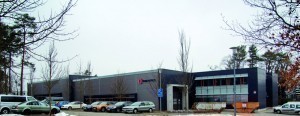 Fabmatics GmbH production halls
Fabmatics GmbH production halls
A new robotic sensor system from TU Bergakademie Freiberg will enable real-time monitoring in drinking water dams and reservoirs as well as newly flooded open-cast mining lakes. This means that even short-term ecological and hydrological changes will be immediately visible. To this end, scientists have been developing special sensors in the ESF project 'Robot-supported inland water monitoring' for a year, which can measure temperature, pressure, pH value, phosphate or mercury content as well as gas and solids content, among other things. A sonar will scan the water from the bottom to the surface. Attached to the autonomous swimming robot, which has also been developed, all relevant data is then continuously recorded during the journey and sent to a base station on the shore. There, the data is processed with the help of artificial intelligence and displayed in three dimensions in virtual reality. "With these findings, we can gain an even better understanding of water as a resource, ensure its high quality for people and the environment and develop concepts for more sustainable use," explains Prof. Yvonne Joseph, coordinator of the project.
Chip giant Intel wants to enable 'robots to feel'. In July last year, a research team from the National University of Singapore presented results to members of the Intel Neuromorphic Research Community that demonstrate the promise of event-based vision and touch sensing in combination with Intel's neuromorphic processing for robotics. The result is a novel robotic system with event-driven artificial skin and vision sensors using Intel's Loihi neuromorphic research chip. The human sense of touch is sensitive enough to feel the difference between surfaces that differ by only a single molecular layer. The researchers hope to achieve the same or even better sensitivity with the artificial skin they have developed, which, according to their research results, can recognize touch more than 1000 times faster than the human sensory nervous system and identify the shape, texture and hardness of objects ten times faster than the blink of an eye.
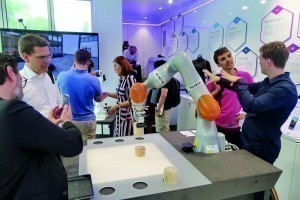 Fig. 7: Kuka robot technology in the CeTI Infomobile Fig. 7: Kuka robot technology in the CeTI Infomobile |
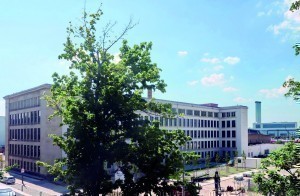 Fig. 8: 'Universal Works' technology center in Dresden Fig. 8: 'Universal Works' technology center in Dresden |
When Prof. Thomas Mikolajick was appointed to a professorship at the Institute of Semiconductor and Microsystems Technology in 2009 and took over the scientific management of Namlab gGmbH, he stated that the objectives of his research and tasks for the Namlab were research into material systems for new device concepts and new nano-based storage technologies as well as the application-specific adjustment of electrical layer properties. Part of the research at the Namlab focused on ferro storage technology. Prof. Mikolajick had already worked on the integration of ferroelectric memory technology into semiconductor production as a team leader at Infineon in Munich in 1999 and, together with his team, developed it into the most modern ferroelectric hafnium oxide memory technology in collaboration with the semiconductor contract manufacturer Globalfoundries in order to deliver top-class non-volatile memories for future innovations in electronics and information technology. On this basis, Ferroelectric Memory GmbH (FMC) was spun off in 2016. It is currently working with major semiconductor companies on an embedded and a stand-alone memory solution. FMC memory technology utilizes the ferroelectric properties of crystalline hafnium oxide (HfO2), which in its amorphous form is already the gate insulator material of every CMOS transistor, from planar to FinFET transistors. The ferroelectric field-effect transistor (FeFET) and capacitor (FeCAP) technology is easy to integrate, fast, low-power and scalable, has a long lifetime with decades of data retention.
FMC's core investor is eCAPITAL (German lead investor in spin-offs such as Sonnen GmbH and Novaled GmbH). Now an international venture capital consortium is also getting involved. This includes the venture capital subsidiary Robert Bosch Venture Capital GmbH, the South Korean SK Hynix Inc. (the world's leading supplier of DRAM, NAND Flash and CMOS image sensors), TEL Venture Capital (Tokyo Electron Ltd.) and imec.xpand (venture capital fund of the Belgian research center imec). The capital will be used to further develop the ferroelectric memory chip technology based on hafnium oxide and to start an international expansion on the US and Asian markets. To this end, the team in Dresden is to be expanded from the current 23 to 62 employees by the end of 2022. "The rise of AI, IoT, Big Data and 5G requires next-generation memory solutions that enable superior speed and ultra-low power consumption and are also compatible with the most advanced CMOS logic processes to guarantee a reduction in manufacturing costs," said CEO Ali Pourkeramati.
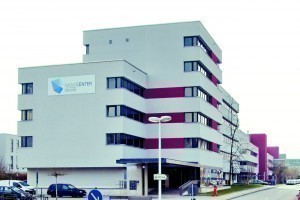 Fig. 9: The startup Ferroelectric Memory GmbH was integrated into the 'NanoCenter Dresden' technology center Fig. 9: The startup Ferroelectric Memory GmbH was integrated into the 'NanoCenter Dresden' technology center |
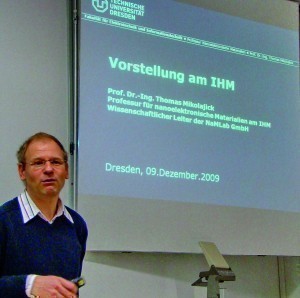 Fig. 10: Prof. Mikolajick at his inaugural lecture in 2009 at the IHM of TU Dresden Fig. 10: Prof. Mikolajick at his inaugural lecture in 2009 at the IHM of TU Dresden |
Launched in May 2019 as a spin-off project at the Institute of Packaging Technology at TU Dresden, MicroPack3D GmbH was founded in August last year. The company offers development and production of electronic packages as well as services in the field of microelectronic packaging technology from a single source. A specially developed process (KONEKT technology) for the electrical contacting and packaging of unpackaged chips, coupled with the possibilities of additive manufacturing, significantly accelerates chip characterization in the development and production of electronic assemblies. This enables the fast and cost-efficient production of even the smallest quantities. For medium-sized companies in particular, this creates the opportunity to develop new business areas through 'rapid electronic manufacturing' or the production of individual assemblies without high set-up costs. In particular, the high flexibility of the housing enables rapid emulation and pin compatibility with standard housings for suitable customer test systems. The collaboration with a pilot customer has now resulted in the first framework agreement for rapidly manufactured test packages in the field of high-performance electronics. "We want to offer 'rapid packaging', especially for high-power devices, to other corporate customers as an important part of rapid product development. Dresden offers an ideal environment for this with the Cool Silicon cluster of excellence in Silicon Saxony," said Managing Director and Head of Development, Dr. Andreas Krause.
Sources:
Announcements from the research institutes
Silicon Saxony e.V. Newsletter: silicon-saxony.de
News portal Oiger: computer-oiger.de
About the person
Dr. Rolf Biedorf has been writing for Leuze Verlag since 1994 and has been reporting on current events in the Saxon microelectronics scene in PLUS for 10 years. After studying chemistry, he worked in the electronics industry and above all at the TU Dresden in research and teaching in the fields of layer and packaging technologies in electronics.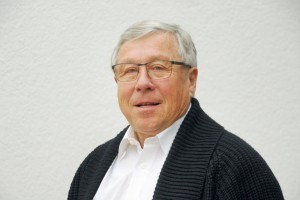 Dr. Rolf Biedorf
Dr. Rolf Biedorf

